If you’re a long-time reader of my blog, you know I try to be as transparent with my readers as possible, so I’m going to give it to you straight on this: I can’t even begin to tell you how disgusted I was when I first tried Molokhia in the Middle East.
The flavor wasn’t bad – it’s earthy, sort-of like spinach, flavor-wise.
But texturally, it’s something else altogether.
Meaning, it’s slimy as heck.
Sort-of like okra, but even more slimy and mucosal than okra, especially if it’s made into soup like this. When you go to take a spoonful, it just seems to move as one unit. But surprisingly the flavor really grows on you. After having this meal three or four times in the Middle East, I was hooked and it became something I craved even home in the U.S.
If you’re not familiar with it, it’s commonly known in the Arab world that Molokhia hails from Egypt and was the food of royalty, as Molokhia literally translates to “for royalty”. In English, Molokhia can be found called Jew’s Mallow, Jute Mallow, Green Mallow, or Nalta. I buy it frozen (which I much prefer over dried) from a local Middle Eastern grocery store.
Molokhia is frequently minced very, very small and made into soup, which is served with either chicken or red meat like beef or lamb, and eaten spooned over rice. This recipe is different altogether – waraq means “leaves” and the leaves are left whole instead of being minced. I like it made with tender, slow-cooked beef. Serve it with fresh lemon for squeezing on top and flatbread (khubz) to scoop it up. (I share a recipe for Middle Eastern flatbread in my cookbook!)
- 4 tablespoons olive oil, divided
- 1½ lbs beef (or lamb) stew meat
- 2½ cups beef stock
- 2 (14 oz/400 g) bags frozen molokhia waraq, thawed (not drained)
- 1½ teaspoons coarse kosher salt (more or less to taste)
- 4 large cloves garlic, crushed using a mortar and pestle or grated on a microplane
- Fresh lemon wedges, for serving
- Fresh Middle Eastern flatbread (khubz), for serving
- Heat 2 tablespoons olive oil in a 5-quart pot over medium-high heat; add half the meat and sear, cooking about 2 minutes per side. Transfer the seared meat to a bowl and cook the remaining meat the same way.
- Add the beef back into the pot along with the beef stock (the stock should just cover the meat). Bring to a boil over high heat, then cover the pot, turn the heat down to simmer, and cook until the meat is tender and the liquid is evaporated, about 1 hour to 1 hour 15 minutes.
- Turn the heat up to medium and stir in the thawed molokhia waraq and the salt; cook until there isn’t any liquid in the bottom of the pot, about 5 to 10 minutes, stirring occasionally.
- Heat the remaining 2 tablespoons olive oil in a small skillet over medium-low heat; add the garlic and cook 1 minute, stirring constantly. Stir into the molokhia.
- Transfer the molokhia to a serving bowl and serve with fresh lemon wedges to squeeze on top and fresh flatbread to scoop it up.
Disclosure: This post contains Amazon affiliate links to products I believe in, which means that even though it doesn’t cost you anything extra, I will receive a small amount of money from the sale of these items, which helps me keep this site alive – thank you for helping to support An Edible Mosaic!

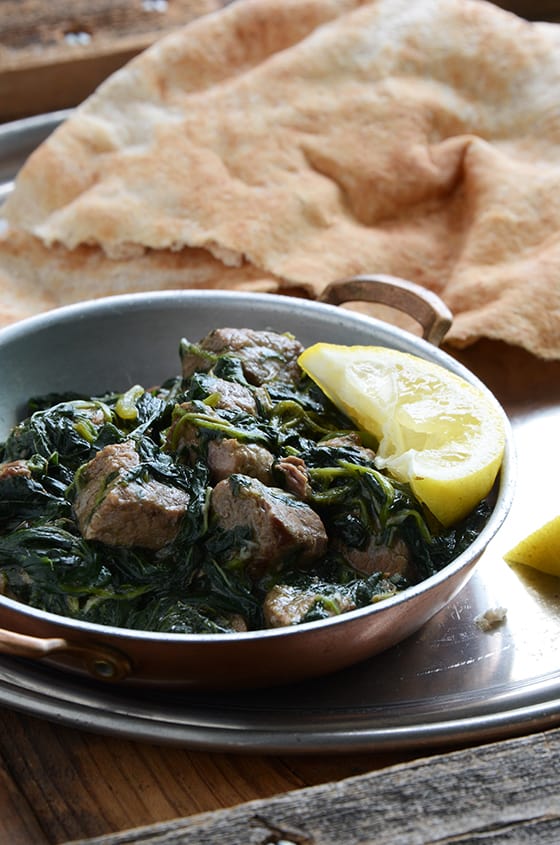
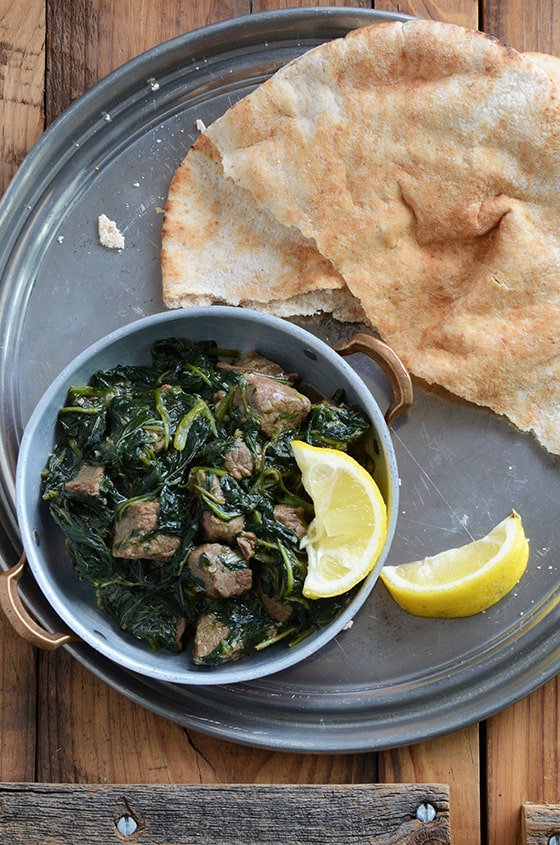
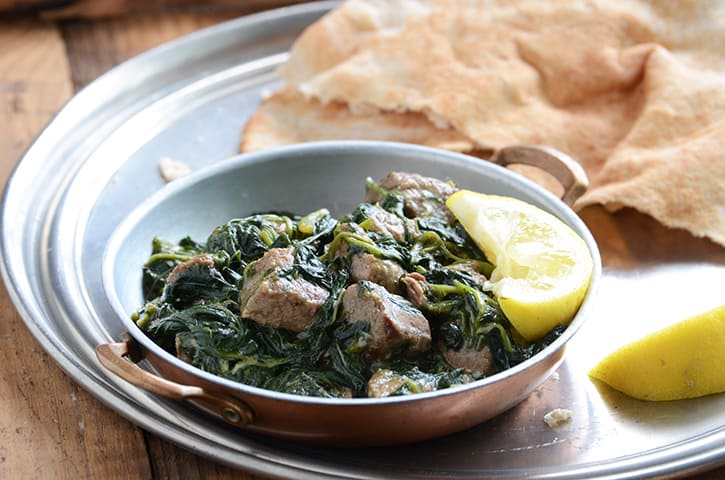
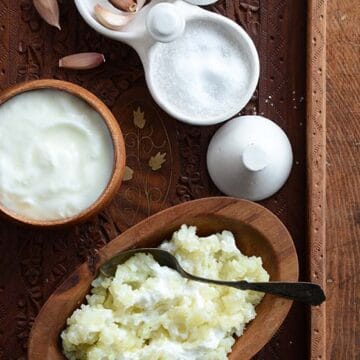
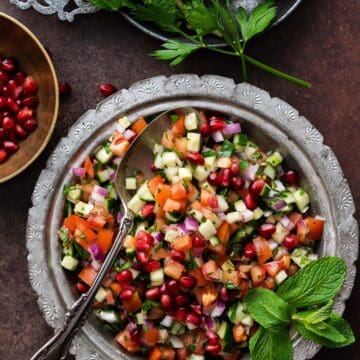
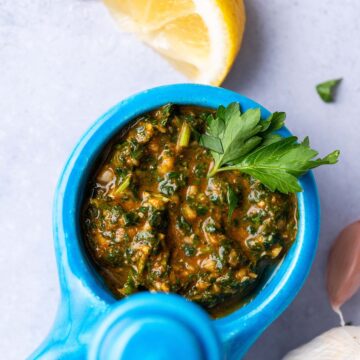
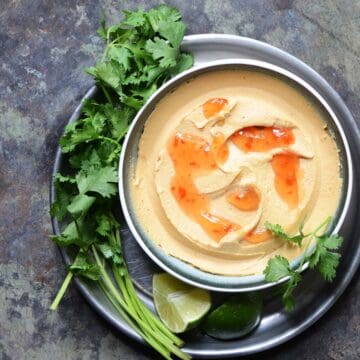
Nora says
This was my favorite food growing up in the Middle East. I crave it all the time now that I'm living in Toronto. It's the first dish I request of my mom when I go back to visit. Thanks to you, I can now try to make it myself! This post has made me so nostalgic!
charlotte says
My husband is Tunisian, and he introduced me to Molokhia. He uses the dried, which requires a completely different process and is DELICIOUS! It also loses it's sliminess. We tried shortcutting with frozen molokhia once, and yeah, slimy.
Try the dried, but look up the Tunisian process. It takes long, but it's the best!
gaia says
this is my favorite dish being a cypriot.We make this dish with lots of crushed tomatoes and olive oil though...and it tastes great with chicken too! I loved your blog and thank you so much for sharing! gaia.
Caroline says
Faith, you know I grew up eating Middle Eastern food, so when I was little, my Mom made Molokhia often. My Dad loved it. I used to eat it, but was never crazy about it. BUT, I've revisited it as an adult and I love it! I am so intrigued by this dish! I've never seen the leaves whole, we only ate the minced version. I love the addition of the beef and that it looks more like a stew than the soupy version. I need to get to the Middle Eastern market soon and look for this! Thanks so much for sharing!
Jarome says
Amazing dish. Now im starving. :)
Veronica says
LOL, thanks for keepin it real, Faith! Now I know what to expect if I try it. :)
dixya| food, pleasure, and health says
i dont know how I feel about slimy greens but now that you mentioned it grows on you - maybe i will be adventurous and try it someday.
Alyssa (Everyday Maven) says
I've never had this but now am intrigued! I am a big fan of okra but usually in stew or crispy so I am thinking I might like it or it would quickly grow on me.
Erica says
hahah...I think you have to either grow to love okra...or cook it the specific way that makes it palatable for you. Living in the south, okra is everywhere! I have never heard of this dish. You always introduce me to new foods to try/love!
Kari@Loaves n Dishes says
Mmm I love me some greens; though I've not eaten Molokhia. I have to try it, so I'll be on the look out for Molokhia from now on. Thanks for introducing me to something new Faith!
Sara @ Magia e Pasta says
Uggh, I feel like the worst Egyptian all the time because I hate, hate, hate molokhia - I just cannot get over the sliminess! I'll have to give it another try, maybe using just the leaves and perhaps making it into a sandwich with pita so the texture of the bread masks the molokhia a little bit...
Deana says
Mallows are terribly good for you... at least the kind with little pink flowers which are a world away from the tropical variety. I had to look it up because I always thought of it as a temperate plant. Who knew a durian and a hibiscus were related? I know I would have trouble with the texture. Very brave of you to try it!!
Faith says
Deana, It's funny, I didn't think of it as being brave when I first tried this dish with my in-laws in the Middle East...it was just dinnertime and this is what we were having, lol. I'm glad I gave it a try more than once because it really grew on me, and to this day is something I love to make for my hubby and I!
Rosa says
Mouthwatering and healthy! A fabulous dish.
Cheers,
Rosa